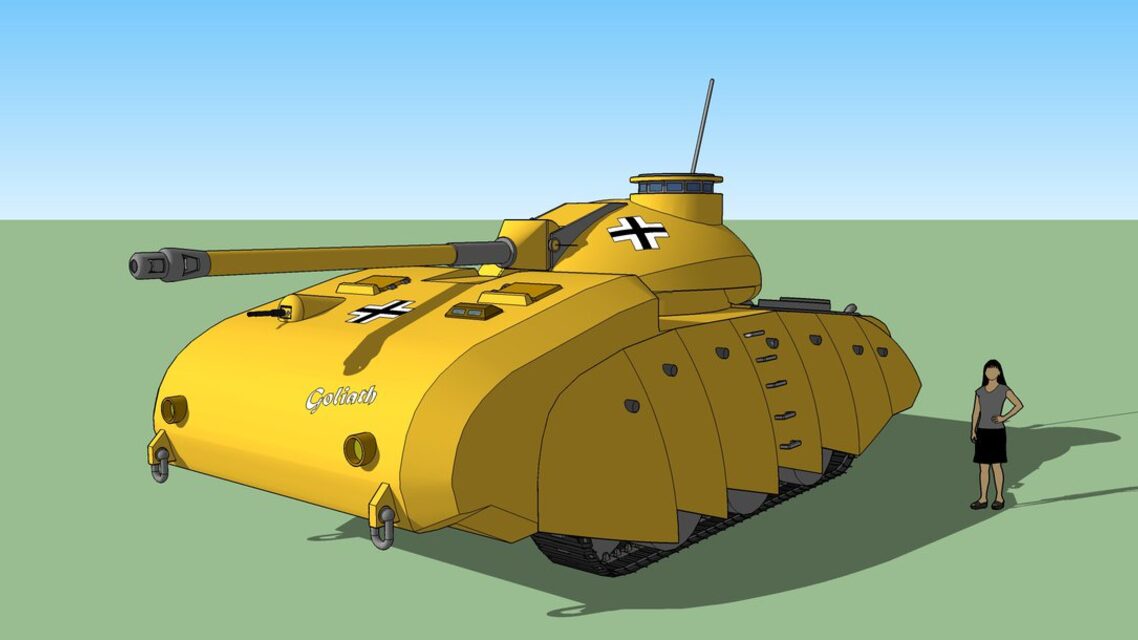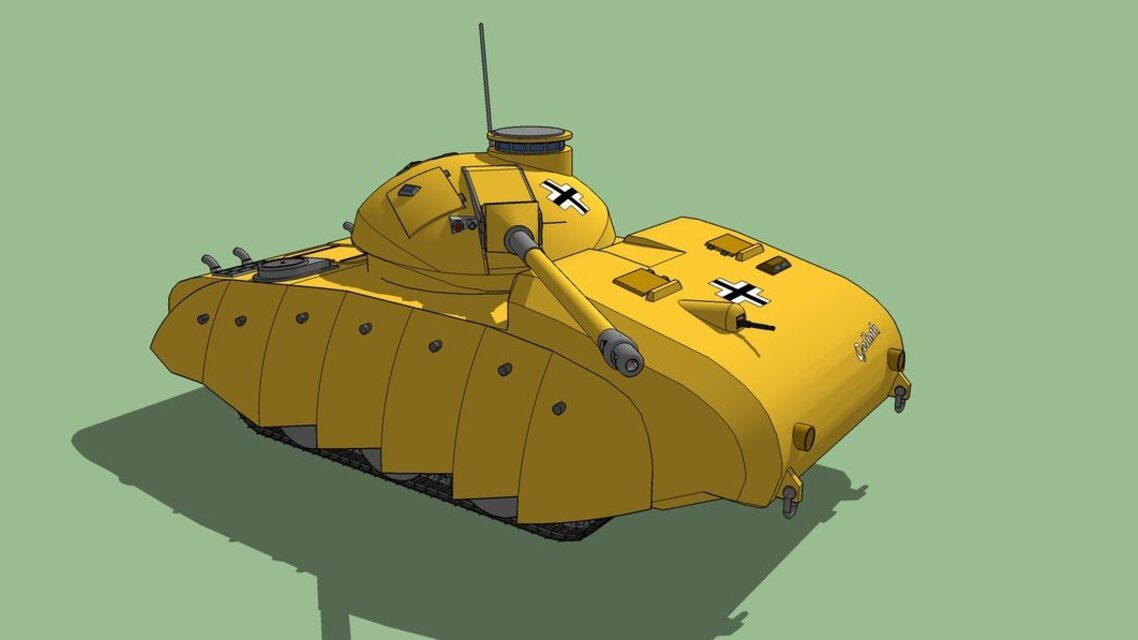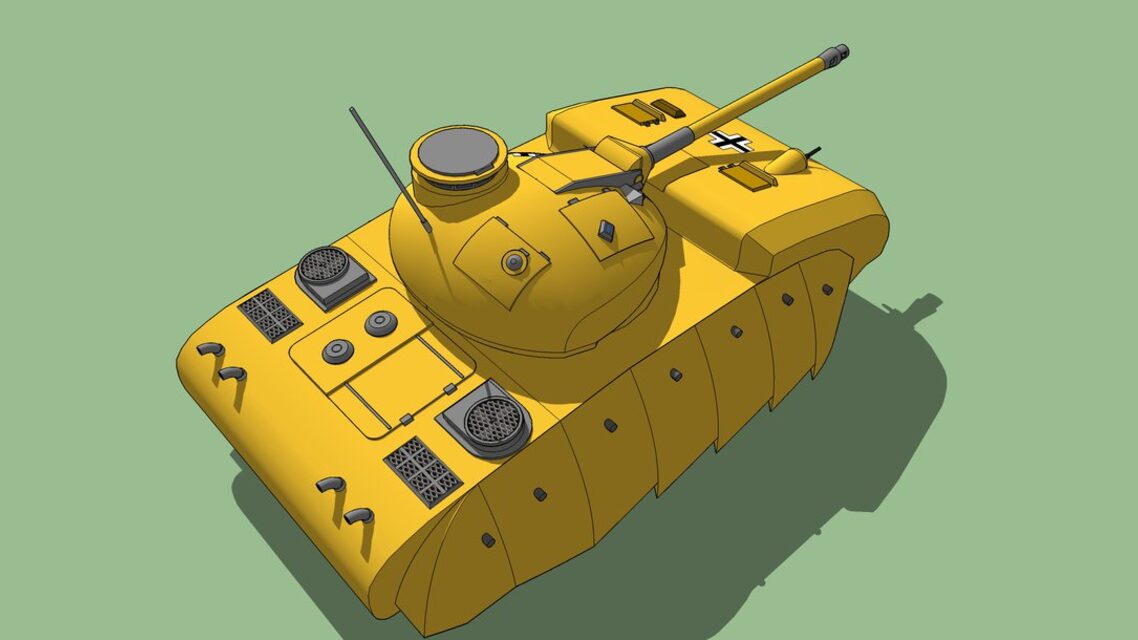- MAIN INDEX: Adolf Hitler Death and Survival: Legend, Myth and Reality
- The Final Years of WWII
- "Operation Paperclip" and Underground Bases
- How the Nazis planned a Fourth Reich...in the EU
- The Great Patents Heist in Germany after WWII
- Did Hitler Have Only One Testicle?
- Argentina
- Nazi Secret Weapons and The Cold War Allied Legend - Part 1
- Nazi Secret Weapons and The Cold War Allied Legend - Part 2
- Nazi Secret Weapons and The Cold War Allied Legend - Part 3
- The "Race" to the Moon"
- Wunderwaffen
- Hans Kammler
- Junkers Ju 390
- Mysterious German Bombs Aircrafts, and Carriers
- German Atom Bomb and WMDs - Part 1
- German Atom Bomb and WMDs - Part 2
- German Atom Bomb and WMDs - Part 3
- Die Glocke
- "Sweats"
- Hitler's Vergeltungswaffen
- The Coming of the 4th Reich
- “We can still lose this war” - General George Patton
- German "Super Science"
- Amerika Bombers
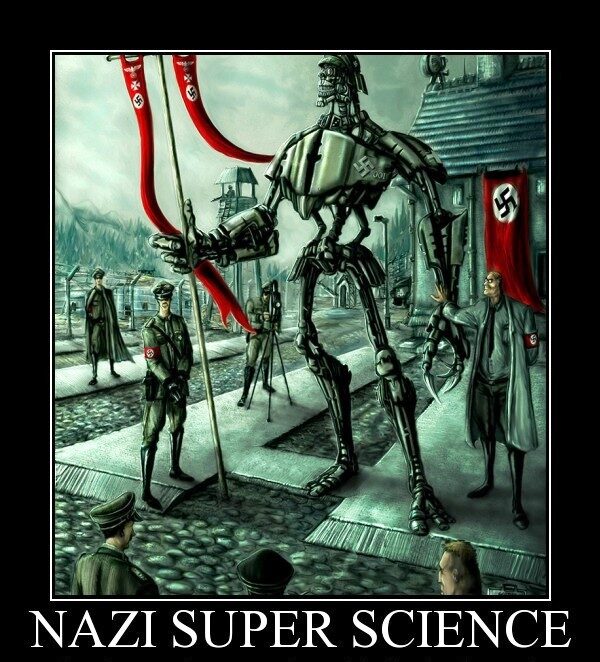
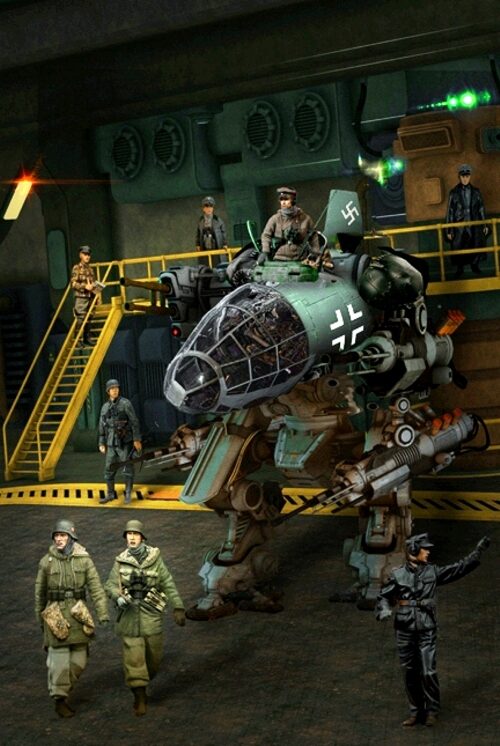
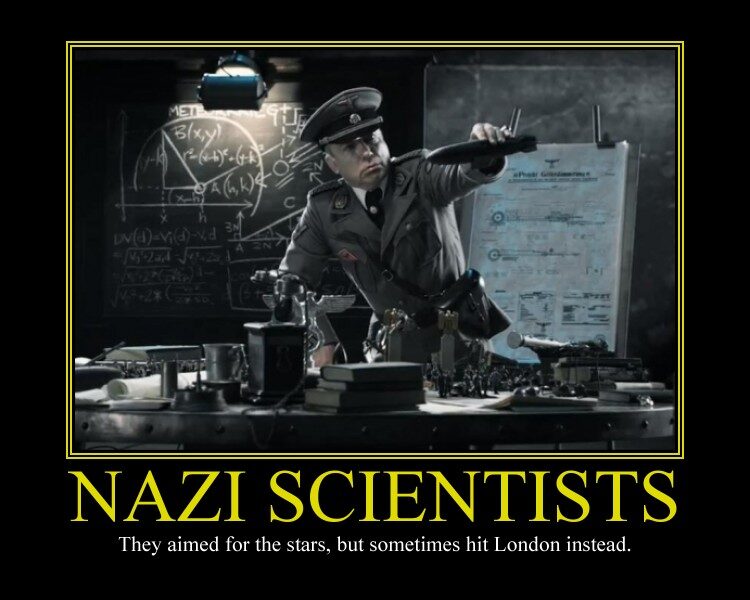

T34-86 Beute Panzer

Panzerfluch Ausf G
Committed to a fearsome anti-armor role, this behemoth crashes through the underbrush with its mere presence instilling dread in enemy tank crews.
While proving highly effective against American Shermans,and the Soviet KV-1s and T-34s, its lack of speed and maneuverability made it desperately vulnerable to anti-tank infantry.
Key Features:
- Cannon terminates in a tightened muzzle break
- Free hand clamp used as self righter, and to carry extra loads of equipment.
- Hatch leads to small compartment for single loader and communications crewman.
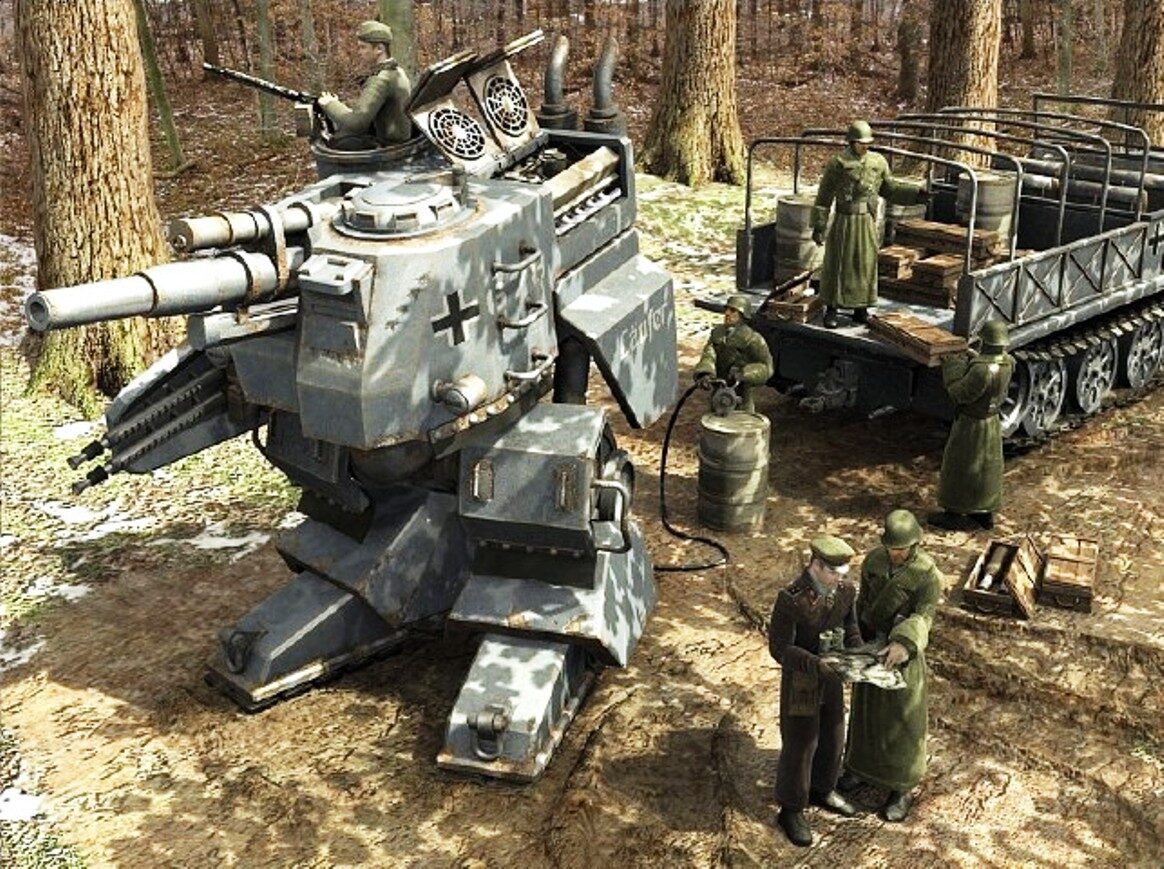
Waffenträgerschreitpanzer "Läufer"
The Armored Walking Weapons Carrier "Läufer" [runner] was a highly mobile self-propelled field artillery piece.
It mounted a short-barreled 75mm cannon in the main body, a MG 34 ring-mount around the main hatch [used for anti-aircraft defense], and a pair of 20mm cannon under a right side "wing" plate.
Seen here is a Läufer is taking on fuel, ammunition, and oil in an Eastern Front forest.
The Läufer favored this sort of terrain, as it tended to be too thick for most tanks and allowed for secure firing positions.
It was popular among the infantry, who liked having close-in artillery support capable of traversing almost any terrain.
The Läufer was a bipedal armored combat machine, designed to accompany infantry, snipe at enemy armor, and generally serve as an all-terrain self-propelled gun.
It had a squat blocky body mounted on two short legs. The howitzer was set to the right of the pilot, with the twin 20 mm cannon mounted to a fixed wing on the far right of the vehicle.
The primary access hatch was behind the howitzer, while the vehicle's engine was directly behind the driver's compartment.
It was roughly 12' tall, 10' long, and 8' wide, weighing 20 tons, and had a top speed of 26 miles per hour, with a crew of three [driver, gunner, loader]).
The Läufer was used on both fronts, and was especially popular in the thick forests of Russia and the broken farmlands of France.
Although not especially well armored, its size and shape made the vehicle easy to hide, and the Allies often found them tucked into barns, factories, deep ditches, thick stands of trees, and the like.
As the howitzer was of limited use against enemy armor, the Läufer was usually used to shell troops in the open or soft vehicle targets -- such as jeeps and trucks. The 20 mm cannon was often used to help spot targets for the howitzer, and tracer rounds were a common load. The MG 34, on the other hand, was meant for close defense and as an anti-aircraft weapon.
Although several hundred Läufer were made, they had little overall impact on the course of the war.
While fine anti-infantry weapons, their high silhouette and thin armor made them walking [literally] targets for Allied tank gunners and ground-attack pilots.
Also, as the war progressed, and parts became scarce, many Läufer were simply abandoned upon experiencing a mechanical failure, although a few were made into semi-fixed artillery platforms.
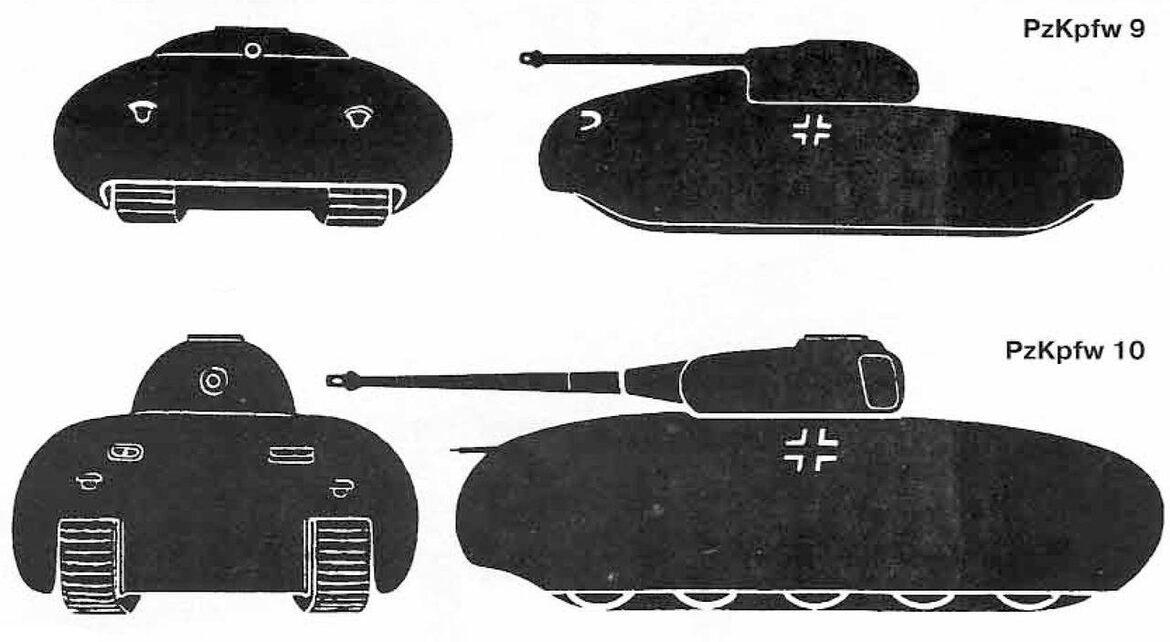
The Panzerkampfwagen IX and Panzerkampfwagen X were silhouette conceptual drawings in the October 1944 edition of the World War II "Signal" magazine, and also appeared in the "Berliner Illustrierte Zeitung".
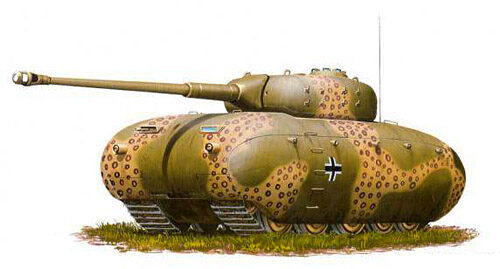
According to "Signal", Panzer X armor was 240 mm in the front and 120 mm on the sides.
The main gun was a 105 mm Kwk, weight was 150 tons.
The drawings were not based on any actual designs; they were solely printed to build up German morale at home and misinform Allied Intelligence about German tank development.
In 1944, the German war industry was not in a position to develop and produce such advanced designs.
At this time, it was not even able to fully supply replacements for lost armored vehicles.
The Panzerkampfwagen IX and X never made it past the preliminary sketch phase.
It is furthermore unclear exactly who designed the vehicles.
For their time they were, however, very ahead of their time. It is clear that the designs were based on combat experience.
Note the following features:
- The turret of the Panzerkampwfagen IX is mounted behind a raised front superstructure to eliminate any shot trap.
- Both vehicles have rounded and sloped armor to provide maximum protection with minimum weight.
- Side protection is integrated into the vehicle rather than being mounted on external brackets.
- The suspension is heavily protected [like modern Main Battle Tanks] on both vehicles..
- The turrets are rounded, especially the Panzerkampfwagen IX's) and "turtle-like". They bear a remarkable resemblance to post-war Soviet turrets.
Clearly these designs marked a radical departure from standard German tank engineering during World War II.
If one examines American tank development through the 1950's, many of the more-radical designs proposed seem to be direct descendants of these vehicles.

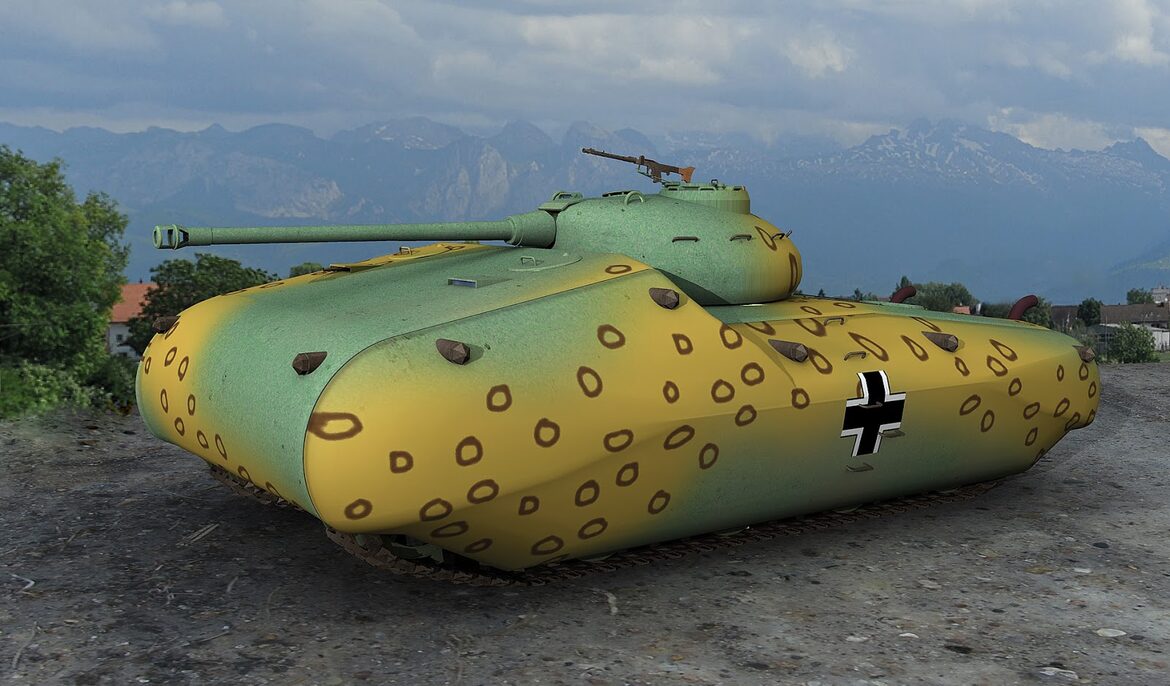
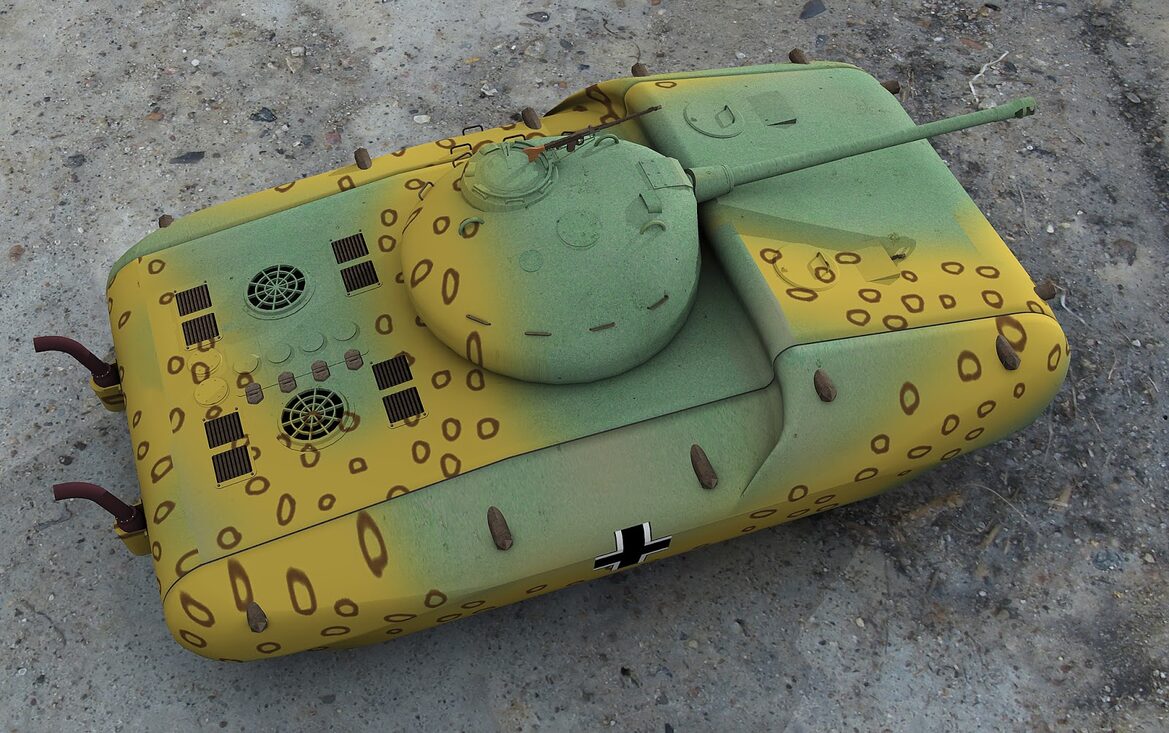
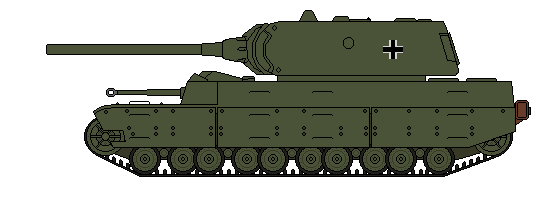
Another Artstic Version of a Panzer IX
Panzer IX Type 6, designed with one main turreted gun, and a secondary gun.
It was to be accompanied by three mediums tanks for protectionas, since it was very slow moving.

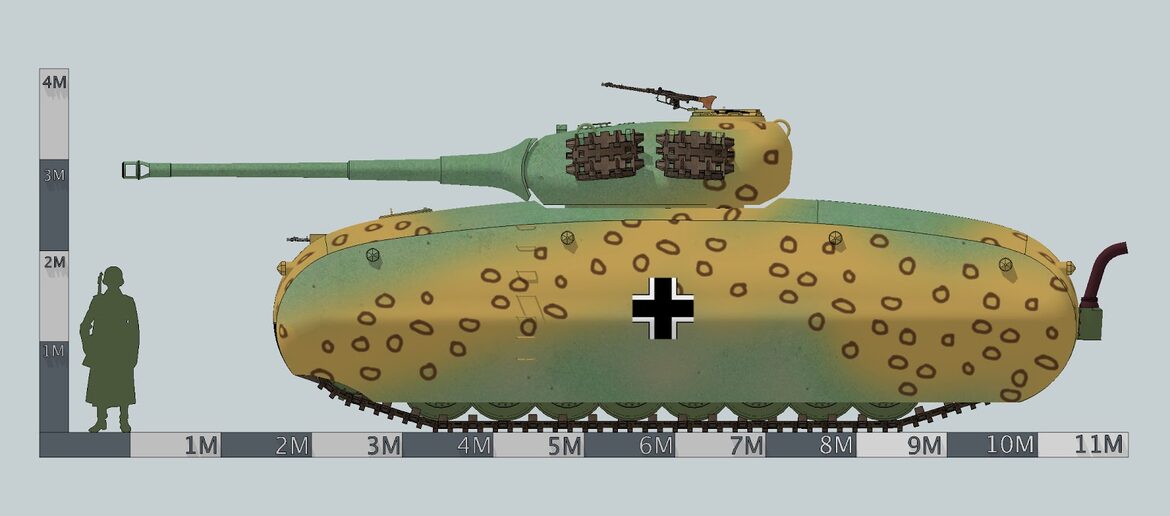
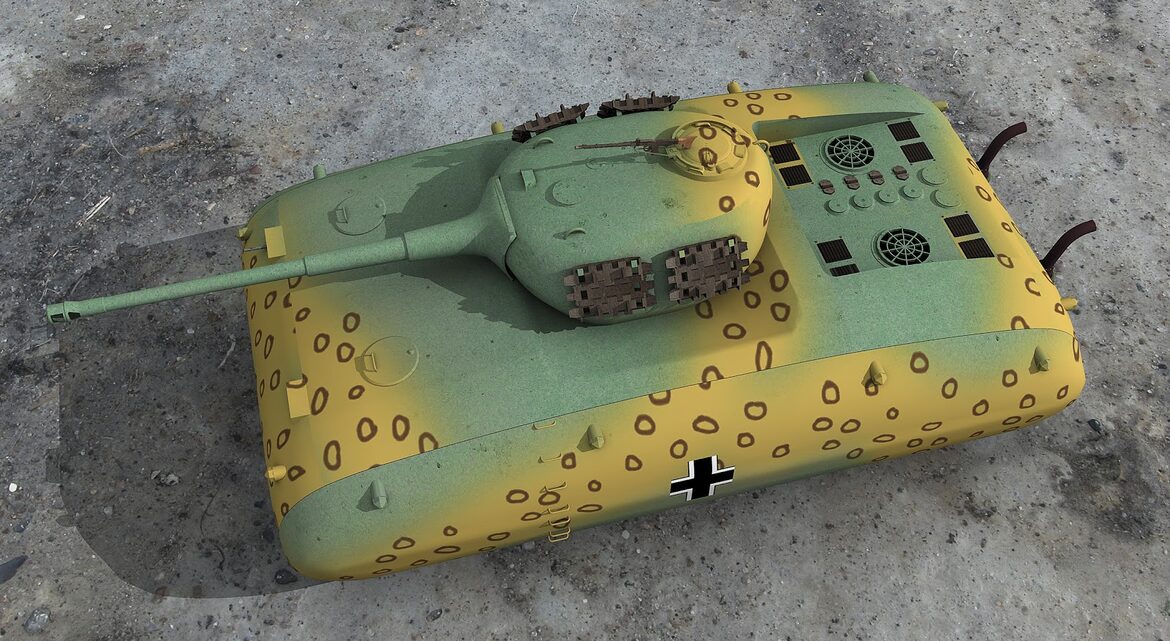
The Landkreuzer P.1000 "Rat" was to be the first of a new kind of“"land battleships" [or "land ironclads" as described by H.G. Wells a century before] a mobile fortress capable of leading an entire Panzerdivision, while covering the offensive with long range, powerful battleships guns, providing anti-aircraft defense, and acting as a mobile HQ.
The Ratte was designed by Krupp’s chief-engineer and officer of submarines, Edward Grotte.
Grotte, however, was not new to the idea of landships; before the war he had assisted the USSR in tank development, proposing many ridiculous monsters, similar to the rat.
His only design that ever was built was a much more modest 25 tons.
Grotte suggested the design to Hitler, who immediately approved the plan in June 1942, naming it “Landcruiser”.
This would have been a 1000ton, ultra heavy tank, equipped with dual 280mm [11 in] SK C/28 naval guns in a Panzerschiff mount, derived from the Detschland-class cruisers.
Secondary armament would consist of between two 12,8 cm [5 in] KwK 44 L/55s, or four to eight 12,7cm [5 in] SK C/34 naval guns, depending on model.
After several design changes, anti-air defense was settled on two Flakpanzer IV Wirbelwind-type turrets, each with quad 2cm [0.79 in] FlaK 38 autocannons.
The tank was so heavy that a unique six track system [two pairs of three] was conceived. Armor was impregnable even to aircraft bombs, with up to 36 cm [1 ft 2 in] of hardened steel plates
No bridge could hope to support such weight, but it could easily cross rivers due to its towering height. The wide hull contained a small bay for BMW motorcycles, several storage rooms, a compact infirmary area and a self-contained lavatory system.
Propulsion was assumed by either two 8,400hp MAN V12Z32/44 24-cylinder U-boat engines, or eight 2,000hp Daimler-Benz MB 501 20-cylinder E-boat engines.
U-Boat snorkels were also fitted for amphibious fording of deep rivers.
Shortly after the project was approved, Albert Speer cancelled it, as well as a self-propelled gun of 1500 tons, the P.1500 “Monster”, armed with the 800 mm [2 ft 7.5 in] Gustav gun, thus ending Hitler’s fantasy of an Empire-like fleet of war machines.
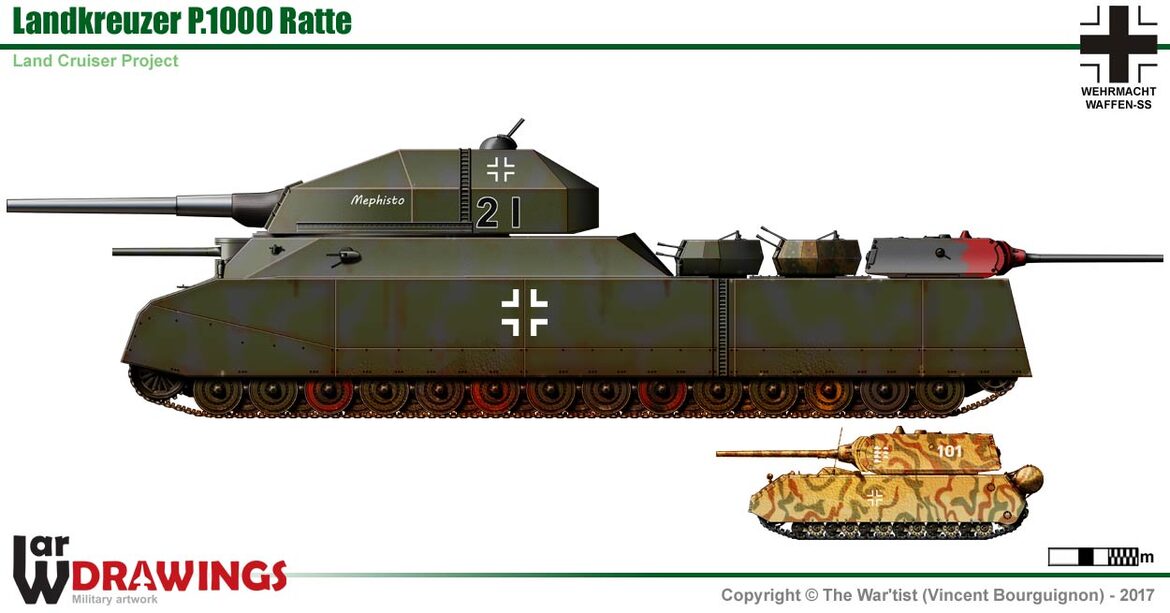

The Heinkel He 111 was one of the most commonly used German bombers during the first years of the Second World War.
Over 5,500 were built in total with several different versions being created along the way, the most unusual of which was easily the He 111Z Zwilling.
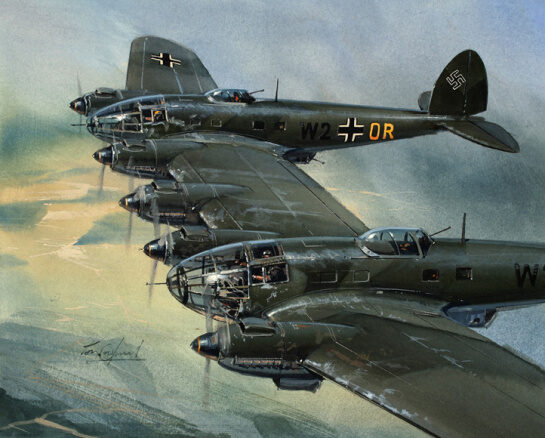 The He 111Z Zwilling was basically two standard He 111's joined at the wing and with an additional engine added in between.
The He 111Z Zwilling was basically two standard He 111's joined at the wing and with an additional engine added in between.
It was originally designed to tow gliders, in particular the large Messerschmitt Me 321.
The He 111Z Zwilling was to replace the previous tow aircraft for the Me 321, which consisted of a trio of Bf 110 heavy fighters flying in a V formation.
Despite its odd appearance, the Heinkel He 111Z Zwilling was rated highly by its pilots.
Four aircraft were originally ordered, with a further 10 later being built, along with 5 more constructed from existing standard He 111s.
Heinkel He 111 Zwilling
Powered by five Jumo 211F engines, each producing 1,340 horsepower, the Heinkel He 111Z Zwilling had a range of 2,500 miles:
It could tow a Me 321, or the smaller Gotha Go 242 glider for up to ten hours.
A variant capable of carrying four anti-shipping guided missiles, as well as 15,870 lbs of bombs was also built, although it never saw action.
A third version, a long-range reconnaissance aircraft, was planned late in the war but never built.
Although the aircraft had two identical fuselages, only the left side fuselage had a pilot.
The crew of seven consisted of
- a pilot, mechanic, radio operator and gunner in the left side
- an observer, mechanic and gunner in the right side fuselage
Overall the Heinkel He 111Z Zwilling saw very little operational action.
Its size meant it could only operate from large airfields.
Although it was originally scheduled to assist in an invasion of Malta, and provide supplies during the Battle of Stalingrad, it was never used.
Many aircraft were destroyed on the ground, although one was shot down by RAF fighters over France on 14 March 1944 while towing a Gotha Go 242 glider.
Four examples survived the war, although they were subsequently scrapped
Nazi Time Machine
By Sarah Haddad
Weekly World News
3 September 2009
One of the world’s leading experts on Nazi Germany says Hitler mastered time itself, sending “time warriors” centuries into the future to conquer a world that is yet to be
Dr. Kurt Fischer told a symposium in Mysen, Norway, that evidence accumulated over the past 64 years has convinced him that the Nazis developed a crude but working time machine before the fall of Germany in 1945.
He says parts of the machine and tattered blueprints were recovered from a bombed-out Bunker in Berlin by Allied forces.
And he suspects that Hitler, long obsessed with paranormal science, might have used the device to propel himself into the future and back on numerous occasions.
“Volumes have been written about the Nazis’ heavy water experiments and Hitler’s obsession with perfecting the atom bomb", said Dr. Fischer. “
But the cutting edge of Nazi technology was concerned with nothing less than the mastery of time and space itself.
“There is evidence to suggest that they did, in fact, open a portal. It couldn’t help them alter the course of World War II. But there is a very real possibility that it gave them a chance to win an even greater victory – the control and domination of our future".
Fischer provided ample documentation for his broader theories during his presentation in Norway.
In a dramatic videotaped interview, secret Nazi physicist Erich Kreiner – now deceased – confirmed that he was one of 28 scientists who conducted the time-travel experiments.
He refused to name his colleagues and appeared to be addled or intentionally evasive when asked to discuss specifics. But he did say the Nazi goal was to send 5,000 elite troops to Germany in the year 2145, which was then 200 years into the future.
“There was some measure of success", he said, adding that several technicians were sent decades into the future and returned to their own time before Germany fell to the Allies.
“I don’t know if there is a connection. But German police reported that a man in Nazi uniform appeared at a power plant near Dresden last August and later vanished from a heavily guarded cell", said Dr. Fischer. “Was that man a Nazi time traveler? Unfortunately, we’ll never know for sure".
Components of the purported time machine that were recovered from the Berlin Bunker have long since been lost, he added. But detailed descriptions contained in Allied inventory reports suggest that it was no bigger than a filing cabinet and was designed to generate light and ultra-high frequency sound waves.
“It’s a chilling prospect, but the greatest threat to our future may not be an enemy that exists today” said Dr. Fischer.
"It might be the Nazis – and a world controlled by a madman".
